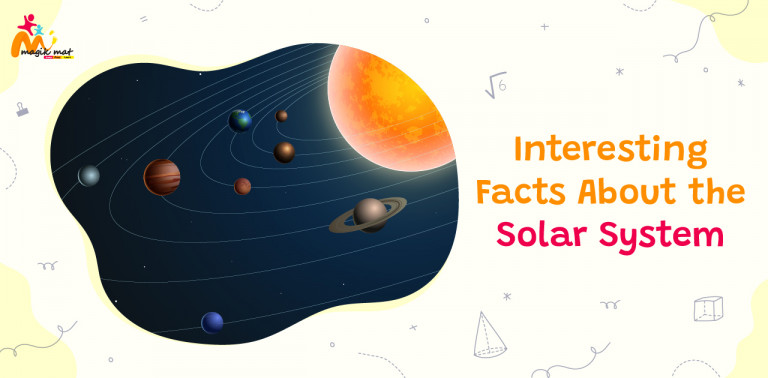Introduction
Do you know that the solar system is full of unbelievable miracles and interesting occurrences that consistently capture the attention of scientists and enthusiasts alike? The solar system is an abundant source of fascinating facts that expand our understanding of the universe, from amazing planetary formations to breathtaking global happenings. It never fails to amaze us, whether it’s the blisteringly hot planets, the mysterious moons, or brilliant astronomical happenings. Prepare to embark on an incredible adventure as we explore some interesting facts about the solar system.
What is Solar System?
The group of stars that revolve around the Sun is referred to as the solar system. The Earth, The Sun, planets, moons, and other heavenly bodies are all part of the Solar System, which is held together by gravity. At the center of the solar system, the Sun, a huge ball of hot gas, emits light and heat and generates the gravitational force that keeps each planet in orbit.
There are many other objects in the solar system besides the Sun and planets. In addition to the outermost planets, it contains billions of other objects. Several thousand planets travel in orbit, mostly between Mars and Jupiter, as they circle the Sun.
About 4.6 billion years ago, a massive interstellar molecular cloud gave rise to the solar system. The entire solar system has a mass of 1.0014 solar masses. The size of the sun is equivalent to one solar mass. Accordingly, the Sun accounts for more than 99% of the mass of the solar system. Pluto was the sixth outer planet between 1930 and August 2006, bringing the number of planets in the solar system to nine. However, the IAU reclassified Pluto as a dwarf planet in September 2006.
Facts About the Solar System
The Sun, eight planets, countless moons, asteroids, comets, and other celestial bodies make up the fascinating and complex solar system. Here are some key facts about the solar system:
- The Milky Way’s Vastness
The Milky Way galaxy, which contains the solar system, has at least 250 billion to 500 billion stars and possibly even more. The Milky Way contains at least 30 times as many stars as there are people on the planet. There are more than 700 known planet-star systems. - The Sun
The Sun is the star at the core of the solar system. Through nuclear fusion reactions, it supplies the energy necessary for life to exist on Earth and makes up 99.86% of the mass of the solar system. - Planets
Mercury, Venus, Earth, Mars, Jupiter, Saturn, Uranus, and Neptune are the eight planets that collectively make up the solar system, listed from closest to farthest. These planets differ in terms of their size, composition, and atmospheric conditions. - Inner Planets
The inner planets, also referred to as terrestrial planets, are Mercury, Venus, Earth, and Mars. They have solid surfaces and are typically made of rock and metal. - Outer Planets
The four outer planets are all gas giants, mostly composed of helium and hydrogen. They feature internal liquid layers and thick gaseous exterior layers. In addition to having several moons, the outer planets also have orbital rings. - Formation
The Sun and the planets were formed together 4.6 billion years ago from a cloud of gas and dust known as the Solar Nebula. It is thought to have originated from a massive molecular cloud of gas and dust. This cloud broke apart, creating the Sun and the planets. - Planetary Ring Mysteries
Since the invention of telescopes in the 1600s, we have known about Saturn’s rings, but it has taken spacecraft and more potent telescopes created in the last 50 years to reveal them. As of today, we are aware that the planets Jupiter, Saturn, Uranus, and Neptune all possess ring systems. The rings, however, vary from planet to planet. For example, no other planet has Saturn’s beautiful halo, which is composed of sparkling, reflective water ice. The other giant rings are probably formed of dust and stony particles. - Saturn’s Rings are 90% Water
The largest ice rink in the Solar System is found on Saturn. The water in its rings has turned to ice due to its great distance from the Sun. It is one of four planets with rings; the other three are gas planets. The rest, however, were not found until the 1970s, when explorers went to investigate them. The first ring system to be observed using a telescope from Earth was Saturn. - Jupiter’s Great Red Spot
The Great Red Spot of Jupiter is bigger than Earth by more than twice. Within this storm, winds can reach as high as 270 miles per hour. The Great Red Spot has been visible on Jupiter ever since people began using telescopes around 400 years ago, though no one is sure when it initially arrived there.
Conclusion
The Solar system has fascinating facts that spark our interest. Learning about the solar system reveals plenty of fascinating information. The solar system is full of wonders, from the astonishing size of space to the minute features of each small body. Its expanse and numerous celestial bodies, including planets, moons, and asteroids, provide countless delights. From the blazing heat of the Sun to Saturn’s cold rings, each component has its own distinct features.
Frequently Asked Questions
How many planets are in the solar system?
The solar system consists of eight planets. They are:
Mercury, Venus, Earth, Mars, Jupiter, Saturn, Uranus, and Neptune.
Which is the smallest planet in the solar system?
Mercury is the smallest planet in the solar system. It is the closest planet to the Sun and has a diameter of about 4,879 kilometers (3,032 miles). Mercury has a radius of about 2,440 km, and its surface area is 74,797,000 km2.
Which is the largest planet in the solar system?
The largest planet in the solar system is Jupiter. It is a gas giant and has a diameter of about 86,881 miles (139,822 kilometers), which makes it more than 11 times larger than Earth in terms of diameter.





